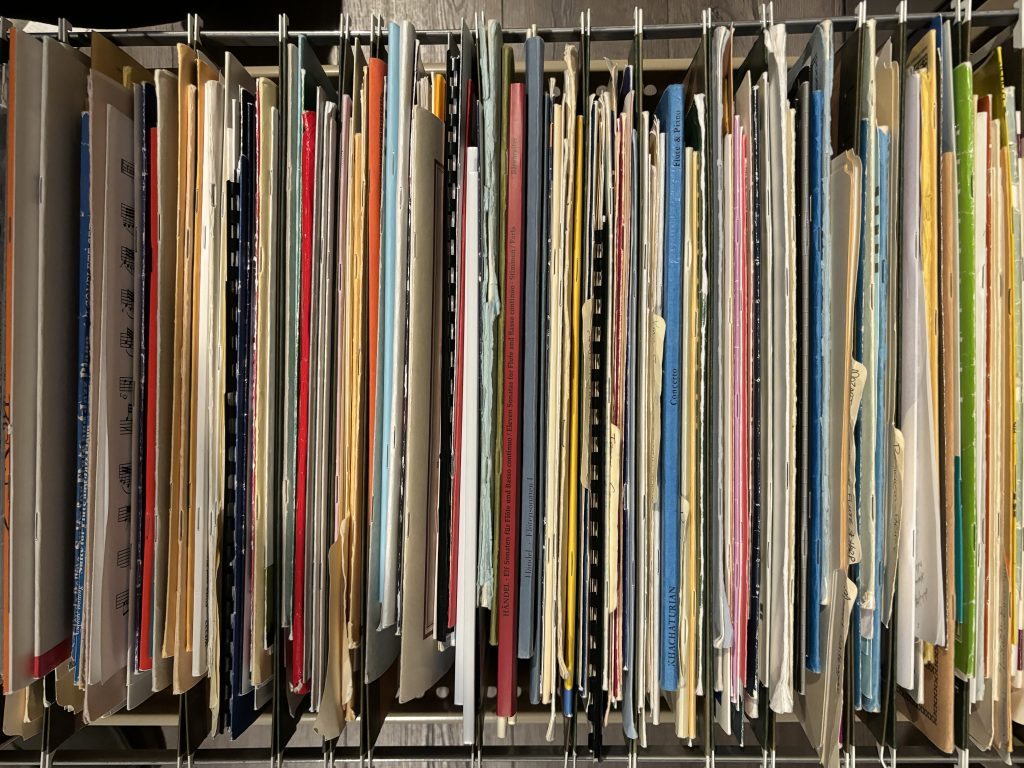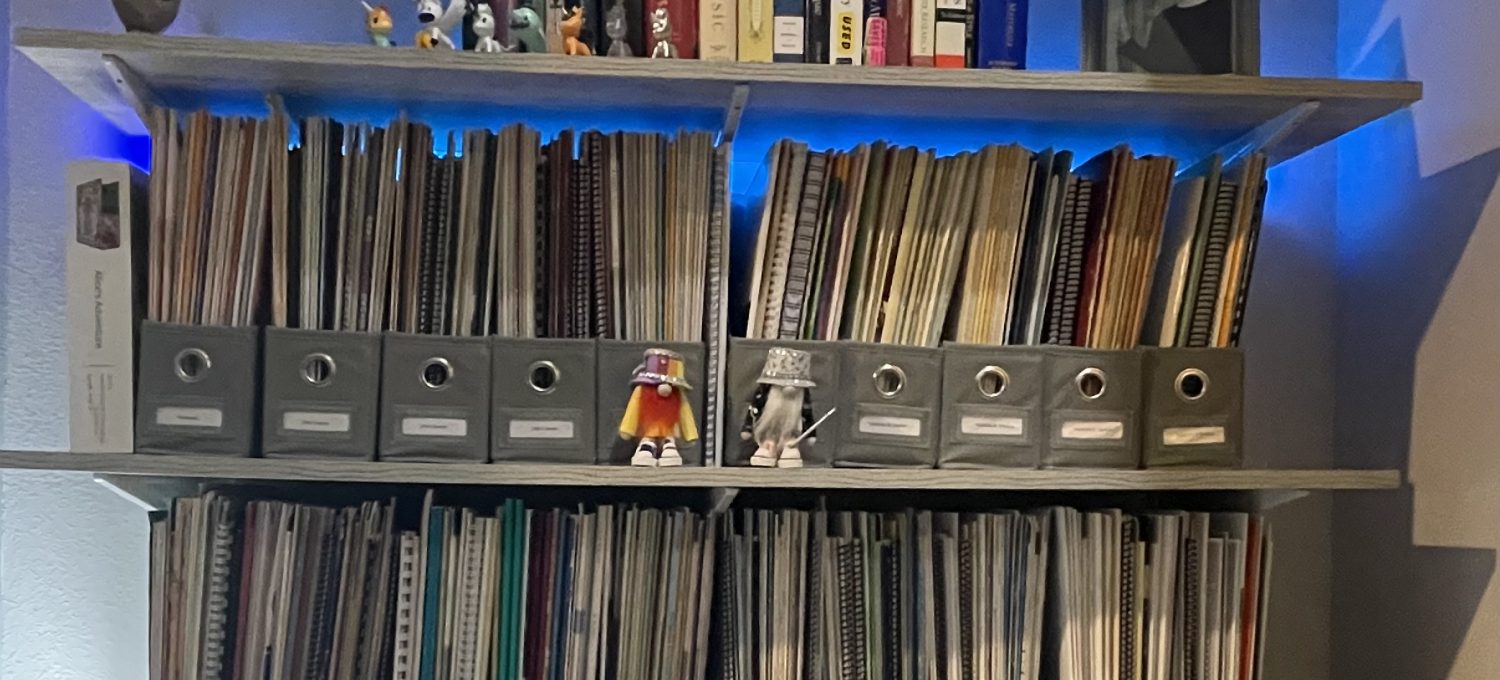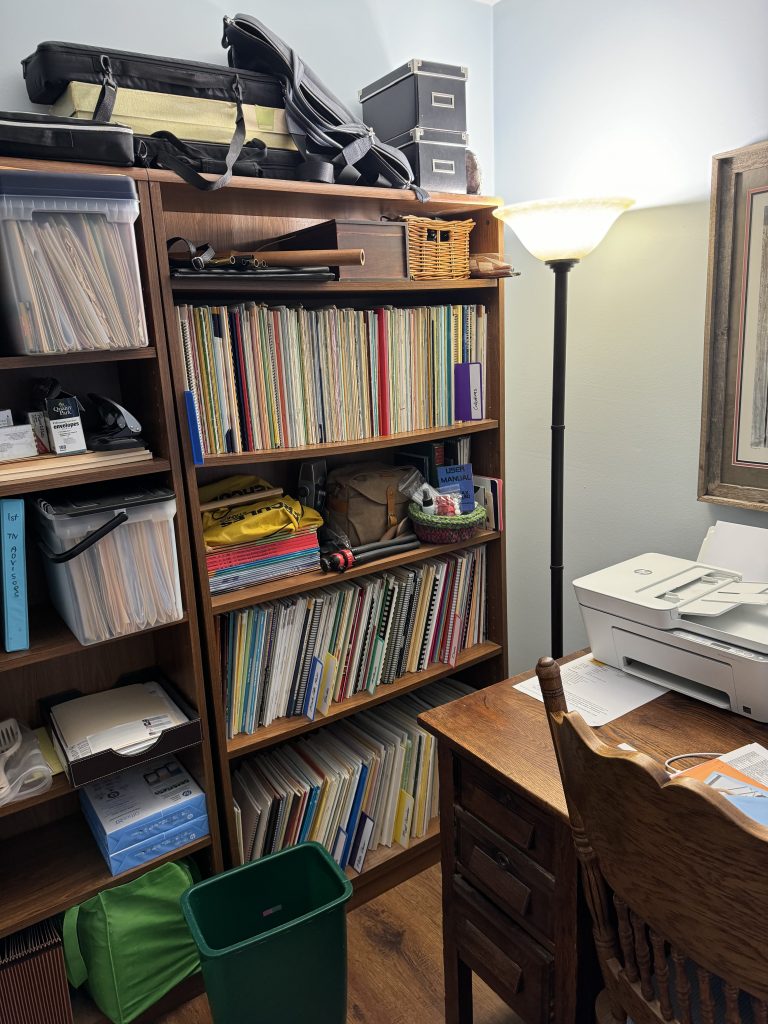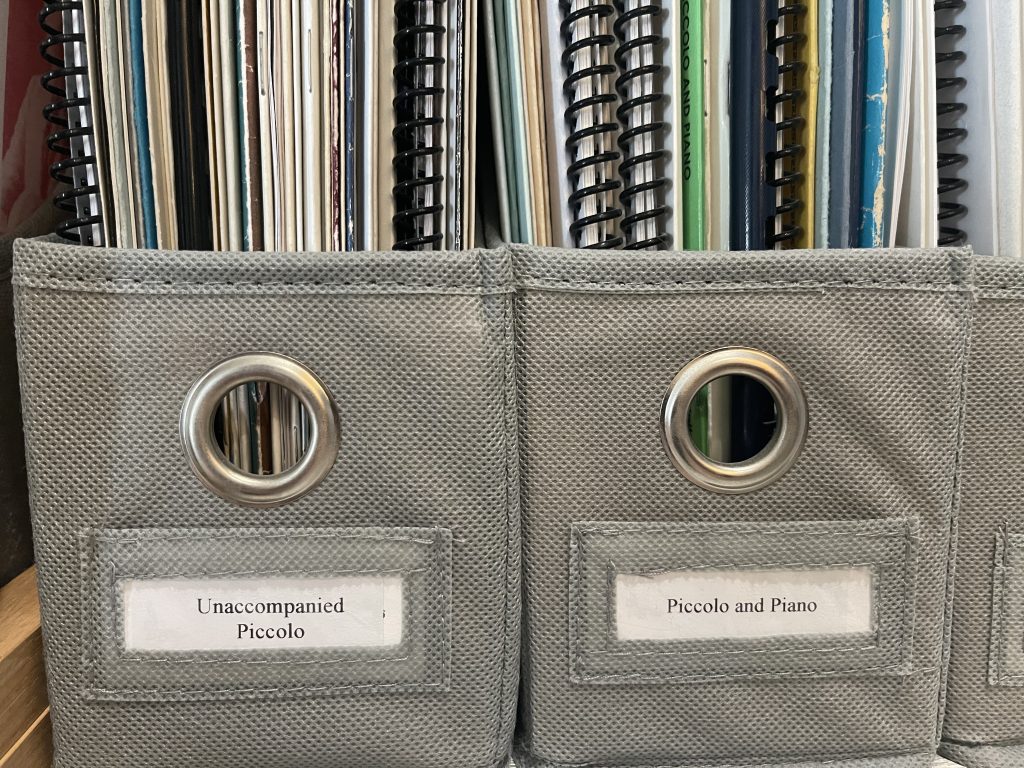(Jessica) If you’re like us, you’ve got a lot of music. Keith, Kelly, and I are all mid-career, we play multiple sizes and types of flutes, and…if we’re being honest…we like collecting! As I’ve moved around the country, I’ve also been gifted piles of music from friends who retire or move out of the field. And from time to time I have been know to purchase a box of music and find out later what is in there. It gets out of hand quite quickly, and I probably don’t spend enough time keeping it all organized, especially once I began to add multiple copies of some things I use a lot so that I could have one at home and one in my office at Vanderbilt. And then I might see one I don’t already have, and…that’s how you get to the point where you have four different versions of Taffanel and Gaubert! My favorite is a Korean publication that has Moyse de la Sonorité and T&G IN ONE VOLUME! This is available on Amazon. Go order a copy. We’ll wait!
In this article, Keith, Kelly and I will show you how we keep our scores in order. In my case, it’s a tall open bookshelf and part of another. I separate my music into these categories: solo (with or without piano), collections, methods, etudes, then duets, trios, quartets, flute choir, mixed chamber, excerpt books and orchestra parts, books of Christmas, church and wedding music for gigs, folk and trad music, and finally, fancy Baroque editions. Then I alphabetize by last name within those categories. If there’s an editor and a composer, I try to choose the one I’m most likely to remember when I’m looking for a score. It takes some effort to make sure it stays organized in this way, but it’s worth it. I also keep two magazine cases out for music that I’m currently using weekly, and I file that away at the end of every semester and start over.
When I was a doctoral student at the University of Maryland, our professor made every one of us create a database of 2000 pieces of solo flute music. It was a herculean task and involved spending insane amounts of time in his basement, where he had rolling library cases filling the space and one little desk in one little corner. However, he also had a lovely long-haired black and white cat who would hang out on your lap, so there were rewards for perseverance! I swore up and down at the end of that project that I would NEVER do that again. Fast forward to a couple of summers ago, when I finally had to admit that my music was out of control. I took my laptop into my home office and sat down and gave in. And I am so glad I did! Here is a screenshot from my music library spreadsheet. Location is H for home or O for office, which has kept me from deciding something is lost and ordering another on more than one occasion! So it’s simple, it does take some effort, but it’s worth doing.
(Kelly) I have a lot of music, as many of do. Unfortunately, our house is not set up to have a dedicated studio space. Before our kids were born, I had one of the upstairs bedrooms as an office. Now we have two kids and my husband works from home in the basement. My desk is in the living room, along with my piano. My primary teaching space is shared space in the basement. I have an IKEA dresser that I use for storing flutes, flute pieces, skeletal models, repair stuff, stand lights, miscellaneous batteries, and music currently in use.
My actual music is in a giant legal-size 4-drawer filing cabinet that my husband was able to get for free from work. It is fully crammed with music and I need to acquire an additional cabinet. Within this cabinet, my music is organized alphabetically by genre. I have flute and piano music combined with solo flute music. I used to have this separated out and now it’s all together, but I don’t remember why. Other categories are excerpts, piccolo, alto flute, etude books, duets, trios, quartets, flute choir, chamber music, and teaching material. This last category has all of the books I use with baby flutelings, as well as pieces and collections that I call “easy solos.”

Like Jessica, I have an Excel spreadsheet with 853 entries. For collections, I have a line for each piece, as well as for the title of the collection. I also have a column to enter the date of when I’ve performed the piece. I copied the format from the music library at Wooster High School where we had an extensive library of band pieces, as well as many cabinets of chamber music which had been donated to us. I used to have a column for where the music was located – all of the teaching material pieces were kept in a filing cabinet in my office at school. In my current job, I’m not in the same room all the time, so I don’t leave any music there.
My newest discovery is the world of digital music and using Forscore on my iPad. My college students told me that I needed to crawl out from under my rock and get with the times. They were right! I love using the iPad because I don’t have to carry as much physical music with me when I teach. For works that my students are working on, I scan the piano and flute parts and upload them to my Google Drive music library. It’s organized with the same categories as my physical library. The move to digital has created an interesting dynamic because some of my newest pieces exist only in digital format. Last summer, I paid a college student to start scanning the physical library. Turns out, it was a much bigger job that either of us anticipated. Eventually, everything will be scanned. I also have pieces that I’m working on, so when I have an unexpected chunk of time (last minute cancellation for lesson for whatever reason), I can practice and be paid for it!
(Keith) As Jessica mentioned, we all love to collect instruments, and music, and play a variety of instruments in a variety of ensembles. During my masters degree, my professor would go through the music catalogue line by line and tell me what to order. Each semester ended up with over $600 of music being purchased. This was the big jumpstart to my library which increased my need for organization. I now have floor to ceiling adjustable shelving on either side of my fireplace to house my collection…and that isn’t even all of it (the piano and vocal music is in the guest room). [The photo at the top of this article is part of Keith’s library!] I have tried quite a few ways to organize my library and even started to database the content (I gave up on that) and have now shifted to magazine files (first IKEA cardboard ones and now a nicer cloth version) to contain the mass of music. I have my flute music, which makes up the majority of the library, grouped by historical category. “20th Century, Baroque, Classical.” Within each category I keep works by the same composer together. All my Ian Clarke pieces are grouped in the same folder. I also have groupings of “Solo Piccolo,” and “ Piccolo and Piano,” and “ Methods and Studies.” I find these groupings work best for me. While it isn’t micromanaged like a card catalog, it works for me. I can find the music I need fairly quickly but it does require a little sifting through items. The groupings keep the search time to a minimum, I do sometimes go through and clean things up and find that I have repurchased something I already had, but such is life.
Due to the large amount of digital copies these days and, as Kelly mentions, using an tablet for music, I also purchased a spiral binding machine. I won’t get into my digital filling system this time! So much music is available for immediate download that I wanted to be able to print it and protect the hard copy. I highly recommend this to everyone. The machines aren’t cheap, but they pay for themselves. I even used the binding machine for my doctoral research (but that is another article for later). I may revisit the database at some point, but for now, this method is working well for me and it doesn’t look bad in my office space, which happens to be the “formal” living room with a fireplace. It looks neat and tidy so having it in full view doesn’t bother me at all.
The bottom line, at least for me, is to figure out what works best for you. This depends a lot on the amount of music, how many different instruments or categories of music you may have, and what makes the most sense to your brain for ease of use. I think knowing what other people have done helped me decide on what was easiest for me to maintain and utilize based on how much time I was willing to commit to the project.




